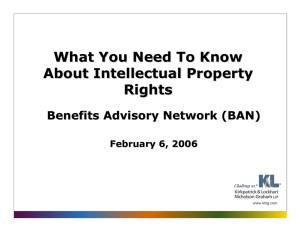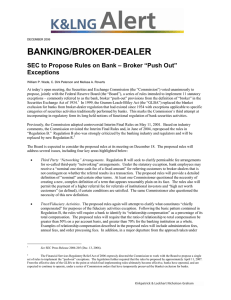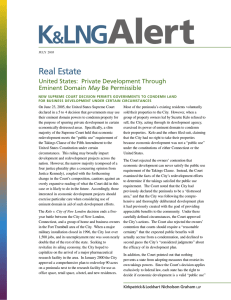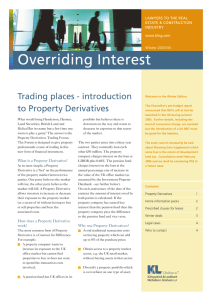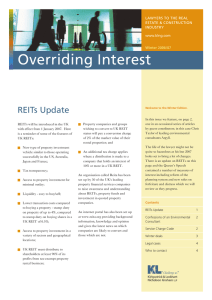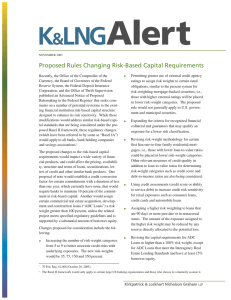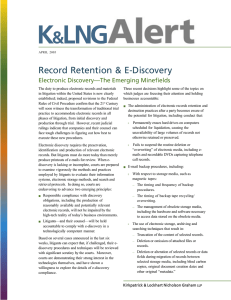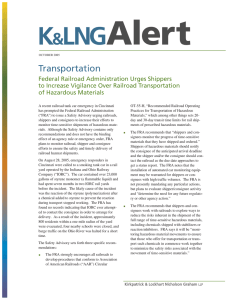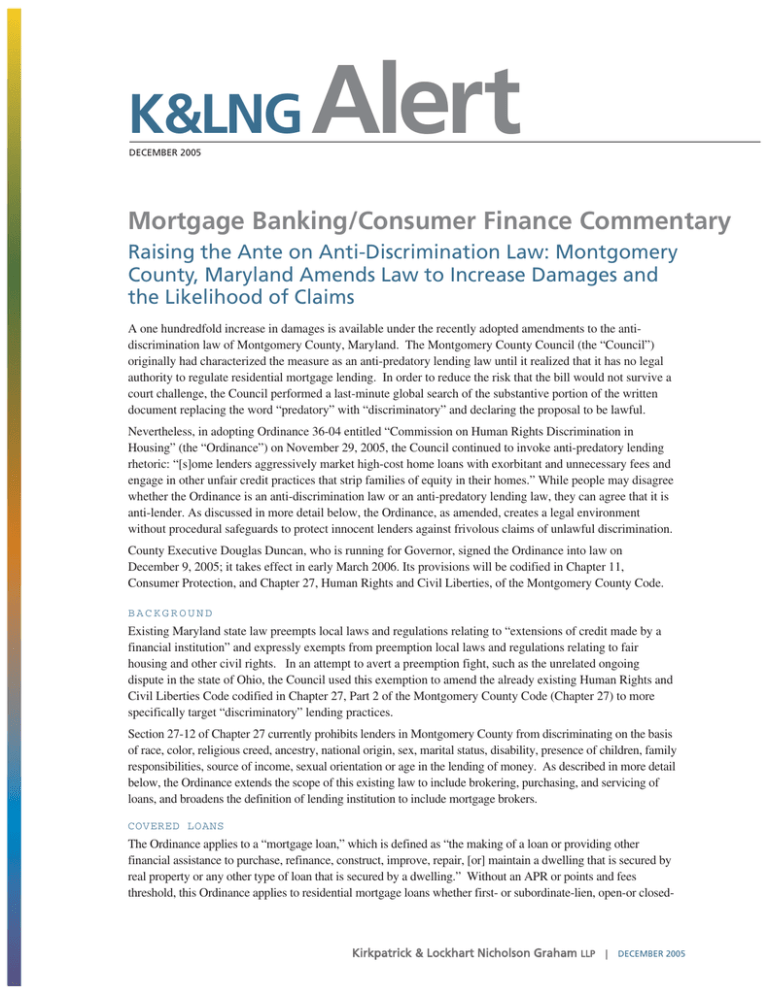
K&LNG
DECEMBER 2005
Alert
Mortgage Banking/Consumer Finance Commentary
Raising the Ante on Anti-Discrimination Law: Montgomery
County, Maryland Amends Law to Increase Damages and
the Likelihood of Claims
A one hundredfold increase in damages is available under the recently adopted amendments to the antidiscrimination law of Montgomery County, Maryland. The Montgomery County Council (the “Council”)
originally had characterized the measure as an anti-predatory lending law until it realized that it has no legal
authority to regulate residential mortgage lending. In order to reduce the risk that the bill would not survive a
court challenge, the Council performed a last-minute global search of the substantive portion of the written
document replacing the word “predatory” with “discriminatory” and declaring the proposal to be lawful.
Nevertheless, in adopting Ordinance 36-04 entitled “Commission on Human Rights Discrimination in
Housing” (the “Ordinance”) on November 29, 2005, the Council continued to invoke anti-predatory lending
rhetoric: “[s]ome lenders aggressively market high-cost home loans with exorbitant and unnecessary fees and
engage in other unfair credit practices that strip families of equity in their homes.” While people may disagree
whether the Ordinance is an anti-discrimination law or an anti-predatory lending law, they can agree that it is
anti-lender. As discussed in more detail below, the Ordinance, as amended, creates a legal environment
without procedural safeguards to protect innocent lenders against frivolous claims of unlawful discrimination.
County Executive Douglas Duncan, who is running for Governor, signed the Ordinance into law on
December 9, 2005; it takes effect in early March 2006. Its provisions will be codified in Chapter 11,
Consumer Protection, and Chapter 27, Human Rights and Civil Liberties, of the Montgomery County Code.
BACKGROUND
Existing Maryland state law preempts local laws and regulations relating to “extensions of credit made by a
financial institution” and expressly exempts from preemption local laws and regulations relating to fair
housing and other civil rights. In an attempt to avert a preemption fight, such as the unrelated ongoing
dispute in the state of Ohio, the Council used this exemption to amend the already existing Human Rights and
Civil Liberties Code codified in Chapter 27, Part 2 of the Montgomery County Code (Chapter 27) to more
specifically target “discriminatory” lending practices.
Section 27-12 of Chapter 27 currently prohibits lenders in Montgomery County from discriminating on the basis
of race, color, religious creed, ancestry, national origin, sex, marital status, disability, presence of children, family
responsibilities, source of income, sexual orientation or age in the lending of money. As described in more detail
below, the Ordinance extends the scope of this existing law to include brokering, purchasing, and servicing of
loans, and broadens the definition of lending institution to include mortgage brokers.
COVERED LOANS
The Ordinance applies to a “mortgage loan,” which is defined as “the making of a loan or providing other
financial assistance to purchase, refinance, construct, improve, repair, [or] maintain a dwelling that is secured by
real property or any other type of loan that is secured by a dwelling.” Without an APR or points and fees
threshold, this Ordinance applies to residential mortgage loans whether first- or subordinate-lien, open-or closed-
Kirkpatrick & Lockhart Nicholson Graham LLP |
DECEMBER 2005
end, prime or subprime that are located in Montgomery County. Real property is not defined under the
Ordinance, so the Ordinance also may apply to loans secured by commercial real estate in Montgomery County.
The Ordinance applies to a “person” – a broadly defined term – that includes a lending institution such as any
bank, insurance company, savings and loan association, or other organization regularly engaged in the
business of lending money, brokering money or guaranteeing loans. A “person” also includes an individual, a
legal entity, or a department agency, instrument of the county or, to the extent allowed by law, of Federal State
or local government.
PROHIBITED PRACTICES
As indicated above, the Ordinance does not amend the scope of the law to create additional protected classes.
However, it does amend the scope of the law in two significant ways. First, it brings within its reach entities
that engage in activities other than lending and guaranteeing loans. Now, loan brokers, loan servicers and loan
purchasers all could violate the Ordinance if they conduct their business in a discriminatory manner. Second,
the Ordinance provides an illustrative list of discriminatory lending practices that often are found in antipredatory lending laws, although the County version includes ambiguous adjectives that make the meaning of
the prohibitions tough to discern.
Specifically, the Ordinance identifies as a discriminatory lending practice, because of race, color, religious
creed, ancestry, national origin, sex, marital status, disability, presence of children, family responsibilities,
source of income, sexual orientation, or age, engaging in the following activities:
■
Steering – which is restricting or attempting to restrict a person’s choices because of factors other
than a person’s income or credit level in connection with seeking, negotiating, buying or renting a
dwelling, including seeking a mortgage loan for a dwelling and includes: (i) discouraging a person
from a particular mortgage loan with more favorable terms if the person may qualify for that
particular mortgage loan; (ii) directing a person away from a housing or mortgage loan product,
program or service with more favorable terms if the person may qualify for that particular product,
program or service; or (iii) offering less favorable mortgage loan terms than would otherwise be
offered; or
■
Making available a mortgage loan which:
– Includes the financing of single premium credit life insurance;
– Provides for excessive up-front points, excessive fees, or excessive prepayment penalties; or
– Provides compensation paid directly or indirectly to a person from any source.
As you can see, the Council has cut and pasted anti-predatory lending restrictions into an anti-discrimination
law. The result is an awkward compromise that will be difficult to administer. For example, the amended law
defines discriminatory lending practice to include the charging of excessive up-front points or excessive fees
because of a prohibited factor. Put aside for a second that the qualifier “excessive” has no meaning since it is
not the charging of excessive fees that is illegal – only the charging of excessive fees in a discriminatory way
that is proscribed. Is charging reasonable fees in a discriminatory manner now legal under the amendments?
In any event, in order to determine whether one borrower is paying more fees than another because of a
prohibited factor, an investigator likely will want to compare and contrast the fees paid by multiple borrowers.
Imagine the discovery request needed to make that analysis.
Similarly, the Ordinance does not prohibit “steering,” only steering as a result of a prohibited factor. As
drafted, it would appear to be perfectly lawful, at least under this law, (i) to restrict or attempt to restrict a
person’s choice of a mortgage loan because of a factor other than income or credit level or (ii) to offer less
favorable mortgage loan terms than would otherwise be offered, or direct a person away from a particular loan
with more favorable terms for which the person otherwise would qualify. Remember, it is not engaging in
these objectionable practices that is unlawful, only engaging in these practices as a result of a prohibited
factor. We predict that investigating and analyzing allegations of unlawful discrimination under these
amendments will be exceedingly difficult, because first one has to determine the occurrence of the predicate
2
Kirkpatrick & Lockhart Nicholson Graham
LLP
| DECEMBER 2005
offense and then make a determination if such act occurred as a result of a prohibited factor. It will be hard
enough to prove the first element, much less the second one. One can imagine the ambiguous complaints by a
disgruntled borrower of wrongful lending without any evidence to support the claim of discrimination.
DAMAGES AND ENFORCEMENT AUTHORITY
Penalties
Upon a finding of a violation of the above discriminatory lending practices, the case review board of the
Commission on Human Rights may order the payment of damages and any other relief that the law and the
facts warrant, such as:
■
Compensation – Monetary compensation for reasonable attorneys’ fees, property damage, personal
injury, unreimbursed travel or other expenses, and damages not exceeding $500,000 for humiliation
and embarrassment, based on the nature of the humiliation and embarrassment, including its severity,
duration, frequency, and breadth of observation by others and financial losses resulting from the
discriminatory act;
■
Equitable Relief – To prevent discrimination and otherwise effectuate the purposes of Chapter 27;
■
Consequential Damages – Including lost wages for employment discrimination or higher housing
costs from housing discrimination; and
■
Any Other Relief – Any other relief that furthers the purposes of the law or is necessary to eliminate
the effects of any discrimination prohibited under the law.
Neither punitive damages nor express assignee liability are available under the Ordinance. However, as
mentioned above, a purchaser could have direct liability for engaging in discriminatory practices.
This revised penalty section raises three warning flags for the industry. First, and most importantly, is the
increase in statutory damages from $5,000 per violation to $500,000. This amount represents a one hundredfold
increase from the prior statutory language and double the amount of damages suggested by Council members in
April 2005. Although obviously intended to chill discriminatory lending practices, this amendment may have
the unintended effect of chilling legitimate mortgage lending practices in Montgomery County.
Second, despite the substantial increase in the cap on statutory damages, the board still retains the authority to
provide “any other relief” that furthers the purpose of the Act, which relief could mean additional economic
damages in addition to the statutory cap. Even though the Ordinance makes clear that punitive damages are
not available, the availability of such significant statutory damages and other uncapped relief makes it likely
that a significant penalty awarded under Chapter 27 could be viewed as punitive in nature.
Third, the penalties are awarded by a “case review board.” The case review board is comprised of three
unelected individuals from the 15 member Commission on Human Rights. The Commission itself is
comprised of volunteers who are political appointees of the County Executive and is designed to represent the
diverse population of the County. While the case review board is served by a staff of civil servants who
conduct the initial investigation and make recommendations, the ultimate decision makers are volunteers who
do not necessarily have the experience or training necessary to make a legal determination of discrimination
and a factual determination of the proper amount of damages to award.
Of additional concern is the ambiguous test for a violation. Under the Ordinance, the act of making,
brokering, servicing or purchasing a mortgage loan based on a prohibited factor is the proscribed act.
Therefore, the Commission could hold a lender, broker, purchaser or servicer liable merely based on the
Commission's subjective views of excessive points, fees or prepayment penalties, or even yield spread
premiums. This means that private residential mortgage lenders in Montgomery County would be judged by
political appointees, who are not elected by County residents or trained as judges, and, as noted above, the law
would apply to virtually all residential mortgage loans made in the County.
Office of Consumer Protection
In addition to amending Chapter 27 of the Montgomery County Code, the Ordinance also amends Chapter 11
concerning consumer protection to “undertake activities and establish procedures to identify, and assist
consumers with respect to, any discriminatory, predatory or abusive lending practices.”
3
Kirkpatrick & Lockhart Nicholson Graham
LLP
|
DECEMBER 2005
A “predatory or abusive lending practice” is “[a]ny representation or marketing practice that is intended to
misrepresent terms or mislead a consumer about the value of financing or buying real estate, consumer goods or
consumer services.” Interestingly, however, the Ordinance did not amend Section 11-4, which section identifies
those practices that are deceptive trade practices and that could trigger its own set of penalties if violated.
Notwithstanding the failure to expressly identify predatory or abusive lending practices as deceptive trade
practices, the Ordinance provides a means for a Montgomery County consumer to effectuate an investigation
of a lender’s business activities. Specifically, any consumer who is concerned about a potentially
discriminatory, predatory, or abusive lending practice in Montgomery County may file a written request for
assistance with the Office of Consumer Protection (the “Office”). Within 20 days after receiving a written
request with all supporting documentation, the Office must review the request and upon review must either:
■
Advise the consumer to file a complaint with the Office if a potential violation of Chapter 11 or
Chapter 27 exists;
■
Assist the consumer in filing a complaint with the appropriate government office or agency that has
jurisdiction; or
■
Provide the consumer with information, education, counseling, or a referral to an appropriate outside
agency, group or organization.
In assisting a consumer with filing a complaint, the Office may consult with any appropriate Federal, State,
County or quasi-governmental office or agency. If the Office assists a consumer in filing a complaint with
another agency, the Office must contact the appropriate agency within 45 business days after the referral to
determine the status of the complaint, and must forward this information to the consumer.
Notwithstanding the burdensome, costly and undesirable effect that such an investigation would have on a
lender doing business in Montgomery County, there is no requirement that the consumer filing such a
complaint have been the victim of a predatory lending practice. The consumer merely needs to be a
prospective purchaser of credit and be “concerned” about a lender’s business practices. Upon meeting this
low threshold of standing, a consumer could launch a detailed government investigation into any lender’s
activities – if that lender happens to make loans in Montgomery County.
THE CONSEQUENCES
So, what is the major consequence of the amendments to the County’s anti-discrimination law? By far, the
single most important aspect of this new law is the addition of two zeros to the maximum amount of damages
that may be awarded for violations of the law in respect of humiliation and embarrassment. The increase in
the damages from $5,000 to $500,000 is like an engraved invitation to file claims against lenders. The reason
for this lies in the process of adjudicating claims that is dictated in the County law and related regulations. It
is important to note that the Director of the Commission on Human Rights has the power to issue subpoenas to
compel the attendance of witnesses and production of documents and other relevant evidence and to conduct
discovery, including interrogatories and depositions. In other words, the Commission on Human Rights can
make a lender’s life miserable in its investigation of the merits of a complaint. Under the County law,
however, both parties first are offered mediation. As noted on the County’s website, “[i]f either or both
parties decline mediation, or if mediation fails, cases are investigated and resolved or settled with the findings
on the merits of the complaint.” In other words, settle the case through mediation or be put through the ringer
with laborious discovery requests.
Of course, one can avoid the disruption of an overbroad discovery request by a quick mediation and
settlement. That is how lenders have handled loan-level HUD discrimination complaints for years much to
their annoyance. Lenders have learned the hard way that the truth of the allegation, even the most
preposterous allegation, doesn’t matter in the resolution of these complaints. Rather, it is cheaper to settle for
a nominal nuisance value than to withstand the wave of withering discovery requests.
Oh sure, lenders sometimes take a principled stand where the claims of discrimination are so outlandish that it is
simply too painful to cave in. We remember one case several years ago where a federally chartered savings bank
confronted a discrimination complaint as a result of denying a loan to a self-employed, investor borrower who
clearly had lied on the loan application. He had listed several of his rental units on his loan application, only a
small subset of which had appeared on his tax returns. When the lender asked him to reconcile the
4
Kirkpatrick & Lockhart Nicholson Graham
LLP
|
DECEMBER 2005
inconsistencies between his loan application and tax returns, he filed a discrimination complaint with HUD
which in turn asked for information on all similarly situated borrowers within the last several years. We asked
HUD to clarify its meaning of “similarly situated.” Did it want the files of borrowers who had lied to the IRS, or
those who had lied to the lender, or both? We refused to provide anything and told HUD that it was scandalous
to spend government time, energy and effort on a discrimination complaint involving a borrower who clearly had
committed a crime in its loan application. In a rare retreat, HUD moved on to the next complaint.
We do not suggest that only meritless claims of discrimination are filed. We, of course, know better.
Nevertheless, a common experience of lenders is frivolous loan-level discrimination complaints that are designed
to extract a quick monetary settlement to avoid the cost of a full-blown government investigation. As distasteful
as such settlements can be, they are easier to digest when the potential damages are relatively small. Absent a
foundation for punitive damages for willful, egregious behavior, the damages available under the federal antidiscrimination laws are substantially lower than those provided under the amended Montgomery County
Ordinance. With a hundredfold increase in the amount of damages available under the revised Montgomery
County law, one can expect that the hands will be out without regard to the underlying facts.
So, how does one balance the legitimate rights of consumers to prosecute bona fide claims of discrimination
and those of lenders to avoid bogus claims for “greenmail”? The answer is not difficult. The rudiments of
civil procedure require that a complaint meet a minimum standard of proof. Namely, in order to survive an
immediate dismissal, a claimant must plead with particularity the facts that support the claim. Merely
claiming excessive pricing or steering because of discrimination would be quickly dismissed based on a
failure to allege facts with specificity to support a claim.
The Montgomery County Ordinance and regulations provide no similar protection against frivolous claims.
Borrower makes a claim. Lender is told it has the opportunity to mediate or settle, knowing that a $500,000
price tag is hanging over its head. If a lender refuses to mediate, the Commission on Human Rights will let
the open-ended discovery requests fly, and the lender will be mired in a miserable morass of so-called fact
finding, before the claimant ever is required to articulate a factual basis with specificity to support the
allegations of unlawful discrimination.
We know the Council knows how to cut and paste anti-predatory lending laws into its anti-discrimination law.
Hopefully, the Commission on Human Rights can cut and paste procedural safeguards from the law of civil
procedure. After all, if it’s good enough for the judicial system, it should be good enough for Montgomery
County, Maryland.
LAURENCE E. PLATT
lplatt@klng.com
202.778.9034
SUZANNE GARWOOD
sgarwood@klng.com
202.778.9892
NANCI WEISSGOLD
nweissgold@klng.com
202.778.9314
ENDNOTES
i
Md. Fin. Instit. Code § 1-209.
ii
While the term “real property” is not defined in Chapter 27, “real estate is a defined term under Section 27-6 of Chapter 27 and means “any interest in land or anything permanently attached to the
loan. Real estate includes residential and commercial property.”
iii
Any merchant who is found to have committed a violation of any provision under Chapter 11 relating to unlawful trade practices is liable for the payment to the County of a civil penalty, recover
able in a civil action, in the sum of not more than $1,000 per violation. In any action brought by the County to enforce Chapter 11, the court may grant such relief as the court finds necessary to
redress injury to persons resulting from the violation. Injunctions and other appropriate relief also are available. Mont. County Code § 11-9.
5
Kirkpatrick & Lockhart Nicholson Graham
LLP
|
DECEMBER 2005
MORTGAGE BANKING/CONSUMER FINANCE PRACTICE
If you have questions about this topic or would like more information on Kirkpatrick & Lockhart Nicholson Graham LLP,
please contact one of our lawyers listed below:
DIRECTOR OF LICENSING
ATTORNEYS
Laurence E. Platt
202.778.9034
Phillip L. Schulman
202.778.9027
Costas A. Avrakotos 202.778.9075
Melanie Hibbs Brody 202.778.9203
Steven M. Kaplan
202.778.9204
Jonathan Jaffe
415.249.1023
H. John Steele
202.778.9489
R. Bruce Allensworth 617.261.3119
Daniel J. Tobin
202.778.9074
Nanci L. Weissgold
202.778.9314
Phillip John Kardis II 202.778.9401
Stephen E. Moore
617.951.9191
Stanley V. Ragalevsky 617.951.9203
David L. Beam
202.778.9026
Emily J. Booth
202.778.9112
Krista Cooley
202.778.9257
Eric J. Edwardson
202.778.9387
Suzanne F. Garwood 202.778.9892
Anthony C. Green
202.778.9893
Laura A. Johnson
202.778.9249
Kris D. Kully
202.778.9301
Drew A. Malakoff
202.778.9086
David G. McDonough, Jr.202.778.9207
Erin Murphy
415.249.1038
Donna R. Nordenberg 202.778.9479
Lorna M. Neill
202.778.9216
Stephanie C. Robinson 202.778.9856
Kerri M. Smith
202.778.9445
Holly M. Spencer
202.778.9853
Erin E. Troy
202.778.9384
Staci P. Newman
202.778.9452
lplatt@klng.com
pschulman@klng.com
cavrakotos@klng.com
mbrody@klng.com
skaplan@klng.com
jjaffe@klng.com
jsteele@klng.com
ballensworth@klng.com
dtobin@klng.com
nweissgold@klng.com
pkardis@klng.com
smoore@klng.com
sragalevsky@klng.com
dbeam@klng.com
ebooth@klng.com
kcooley@klng.com
eedwardson@klng.com
sgarwood@klng.com
agreen@klng.com
laura.johnson@klng.com
kkully@klng.com
dmalakoff@klng.com
dmcdonough@klng.com
emurphy@klng.com
dnordenberg@klng.com
lneill@klng.com
srobinson@klng.com
ksmith@klng.com
hspencer@klng.com
etroy@klng.com
snewman@klng.com
Stacey L. Riggin
202.778.9202 sriggin@klng.com
REGULATORY COMPLIANCE ANALYSTS
Dana L. Lopez
202.778.9383
Nancy J. Butler
202.778.9374
Marguerite T. Frampton 202.778.9253
Jeffrey Prost
202.778.9364
Allison A. Rosenthal 202.778.9894
Jonathon P. Schuster 202.778.9883
Brenda R. Kittrell
202.778.9049
Joann Kim
202.778.9421
Teresa Diaz
202.778.9852
Robin L. Dinneen
202.778.9481
Danielle M. Taylor
202.778.9058
dlopez@klng.com
nbutler@klng.com
mframpton@klng.com
jprost@klng.com
arosenthal@klng.com
jschuster@klng.com
bkittrell@klng.com
jkim@klng.com
tdiaz@klng.com
rdinneen@klng.com
dtaylor@klng.com
www.klng.com
BOSTON • DALLAS • HARRISBURG • LONDON • LOS ANGELES • MIAMI • NEWARK • NEW YORK • PALO ALTO • PITTSBURGH • SAN FRANCISCO • WASHINGTON
Kirkpatrick & Lockhart Nicholson Graham (K&LNG) has approximately 1,000 lawyers and represents entrepreneurs, growth and middle market companies, capital
markets participants, and leading FORTUNE 100 and FTSE 100 global corporations nationally and internationally.
K&LNG is a combination of two limited liability partnerships, each named Kirkpatrick & Lockhart Nicholson Graham LLP, one qualified in Delaware, U.S.A. and
practicing from offices in Boston, Dallas, Harrisburg, Los Angeles, Miami, Newark, New York, Palo Alto, Pittsburgh, San Francisco and Washington and one
incorporated in England practicing from the London office.
This publication/newsletter is for informational purposes and does not contain or convey legal advice. The information herein should not be used or relied upon in
regard to any particular facts or circumstances without first consulting a lawyer.
Data Protection Act 1988—We may contact you from time to time with information on Kirkpatrick & Lockhart Nicholson Graham LLP seminars and with our regular
newsletters, which may be of interest to you. We will not provide your details to any third parties. Please e-mail cgregory@klng.com if you would prefer not to
receive this information.
© 2005 KIRKPATRICK & LOCKHART NICHOLSON GRAHAM LLP. ALL RIGHTS RESERVED.
Kirkpatrick & Lockhart Nicholson Graham
LLP
|
DECEMBER 2005

